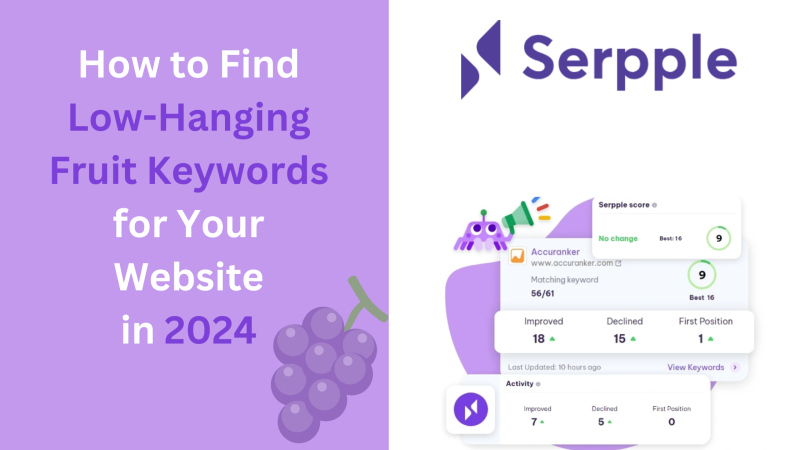Low hanging fruit keywords are a gold mine for getting to top positions on search engines and boosting organic traffic to your website without spending tons of money, but the question is where to find them.
In this article, I’ll show you how to find low hanging fruit keywords both manually and using keyword research software, along with practical tips for including them in your content strategically.
How to find low hanging fruit keywords manually
Let’s start by defining low hanging keywords.
They’re search queries and phrases that are relatively easy to rank for on Google and other search engines because the competition isn’t high.
They can often be pretty specific or niche, and they have lower search volume than broader, more general keywords, but don’t let that discourage you, as they can help you drive highly-targeted traffic to your website.
For example, keywords like “project management tools” are pretty broad and competitive, but the low-hanging version of that keyword could be “project management tools with Gantt charts” or “cloud-based Kanban project management tools”, allowing you to position your product to a target audience that’s looking exactly for that.
Here are a couple of tips on how to find long-hanging fruit keywords manually:
Brainstorm ideas with ChatGPT
ChatGPT can be an unlimited source of keyword ideas if used correctly. Here’s how I’d use it:
- Identify seed keywords related to your topic or industry.
- The second step is not necessary, but it can improve the quality of results you get: you can briefly describe to ChatGPT who is your target audience, what is their search intent, what is your product or service, etc.
- Then, ask ChatGPT to provide you with variations and expansions of the keywords you entered. You can ask it to suggest related terms, questions or long-tail keywords based on the ones you entered.
- If you’re unsatisfied with the results, you can always re-prompt ChatGPT by providing more details.
If you want to explore those keywords further and find their search volumes and keyword difficulty, check out the best SEO tools for freelancers to help you get more accurate data without breaking the bank.
Use Google Autocomplete
This simple yet powerful method can give you insights into user behavior and search intent, as its suggestions are usually based on real search queries made by users.
Google can help you discover long-tail keywords you haven’t thought of and frequently asked questions related to your keywords.
Simply type the seed keywords related to your topic, observe its suggestions and add relevant ones to your Google Keyword Planner for future use.
Here are some phrases you can type to discover even more keywords:
- How to: Start with “how to”, followed by a relevant topic or action related to your niche. For example, “how to build a website” or “how to do search engine optimization”.
- What is: You can use “what is”/”what are” queries to target people at the top of the funnel, see what they’re searching for and provide them with educational content. For example, “what are low-hanging fruit keywords”.
- Best: Type “best” followed by a product or service from your offering. For example, “best smartwatch for women” or “best app for project management”.
- Top: Type “top” followed by a category, as it can help you identify popular items or trends in your industry. For example, “top apps 2024” or “top SEO trends”.
- Comparison: You can see what people are comparing your product or service with by using comparison-related keywords. Type the name of your product followed by “vs” or “or” and see what you can get. For example, “video conference vs” or “video conference or”. You might be surprised!
Check related searches
Scroll to the bottom of Google search results and look for the Related searches section, which offers keyword ideas that can often be closely related to your main keyword, but have lower competition.
These suggestions are based on Google’s algorithm, which analyzes user behavior and search patterns, showing you queries that are often searched together. It means that a certain percentage of users who were googling your main keyword might click on one of the suggestions with less competition, where your article can stand out!
This feature can help you find synonyms and alternatives for more competitive keywords, and work your way up to the first position on Google.
Talking about Google, don’t forget that you can also use Google Search Console to monitor search queries that are bringing the most organic traffic to your website.
Track Google Trends
Google Trends is a free tool for identifying emerging trends and discovering new keyword opportunities before your competitors find them.
Simply enter keywords or topics related to your niche and explore topics that are currently popular or gaining traction. Make sure to check out the trend graphs that are showing interest over time. Look for patterns such as seasonal fluctuations or spikes in interest over particular periods of time.
You can identify peak seasons or periods of increased interest for certain keywords and mark them in your content calendar to prepare ahead of time and optimize website pages for seasonal keywords.
Also, pay attention to emerging trends and queries experiencing a sudden increase in interest, as those may turn out to be your low hanging fruit keywords. Just make sure to act quickly and create content covering those queries before they become more competitive!
Spot them in competitors’ content
Analyze the content of your competitors or websites ranking for similar keywords. Look for phrases or terms they’re targeting, particularly those with lower search volumes or less competition.
If you’re not sure who your competitors are, you can easily spot them among search engine results pages ranking for your target keywords, or even better by using a competitor keyword analysis tool. Here are some tips that will help you find not-that-obvious keywords in the competitor content:
- Check the keyword density of their content. If you spot words or phrases that appear frequently throughout the page, they’re likely their keywords.
- Look into title tags, headings and subheadings, as they often contain keywords your competitors want to prioritize.
- Analyze the anchor text used in backlinks pointing to your competitor’s website. If the same phrase appears in multiple anchors, that is most likely one of their keywords.
Also, whenever I talk about competitors, the question of branded vs non-branded keywords inevitably comes up. I’ve linked a whole guide I’ve written to help you decide whether you want to use them.
Important: While these methods can help you come up with valuable insights and suggestions, they’re not 100% accurate. I’d suggest using a keyword research tool to check factors like search volume, competition level and estimated traffic potential when deciding which keywords to prioritize.
How to find low hanging fruit keywords with Serpple
What if I told you there was a much faster and more convenient way to find dozens of low-hanging keywords and rank for them?
Here’s how to do it with Serpple, one of the best tools for long-tail keyword research.
First, come up with topics and queries that are related to your product or industry. If you don’t know the exact keywords yet, don’t worry, as Serpple will help you find them.
- Sign up for a free trial here
- Enter your domain and website URL.
3. Enter a keyword and choose the region for which you want to do keyword research.
4. Our keyword explorer will provide dozens of related terms and ideas. As shown in the picture below, you can see the search volume and competition level for every keyword suggested.
5. You can now filter for low-difficulty keywords. We suggest focusing on keywords with a keyword difficulty score less than 30, especially if they also have a decent search volume (I suggest aiming for keywords with at least 100 searches per month).
6. To save all low-hanging keywords you’ve found, you can create a cluster called “Low-hanging fruit keywords”, and every time you find one of them, just add it to that cluster so you can have all of them in one place.
Bonus tip: In my keyword research best practices, I always suggest focusing on long-tail keywords rather than short-tail keywords, not only because they have lower competition and are easier to rank for, but also because they’re more specific, which helps you attract your target audience and increase your conversion rate.
Would it be possible to do this with other SEO tools? Probably, but it’d take so much time as Ahrefs and alternatives don’t have a dedicated feature for finding low-hanging keywords, and it’s rare to find the tool that offers:
- Low hanging fruit keyword suggestions
- Filtering by low competition and low difficulty
- Easy way to group and store all low-hanging keywords in one place
Also, the game doesn’t stop once you rank for particular keywords. If you want to keep those first results on Google, you must constantly monitor your keyword rankings and ensure no one outranks you, especially if you work in a competitive niche.
The good news is that you can leave that part to Serpple, the best keyword rank tracking software, that will notify you whenever your rankings change.
Check out this article to learn how to track search engine rankings.
How to incorporate low hanging fruit keywords into your content
Here are five proven ways to optimize your website content with the low-hanging keywords you’ve just found:
Create targeted content
If you don’t know how to optimize your existing content for the keywords you’ve found, why not try creating content addressing those specific queries?
Incorporate the keywords naturally throughout the content, and don’t forget to add them in headings and subheadings as well as the first paragraph of the article. At the same time, you have to avoid keyword stuffing, which is an outdated SEO strategy as it may lead to penalties from search engines.
If you’re lacking content inspiration and ideas, this article on how keyword tracking helps in finding new content could help you a lot.
Optimize metadata
Optimizing meta-data is one of the main factors to rank higher on Google. It can boost your website visibility but also help you improve your click-through rate by adding specific keywords relevant to your target audience and stirring their curiosity.
Here’s where you should add low-hanging fruit keywords:
- Title tag
- Meta-description
- ALT tags
Of course, make sure your meta-data is concise, informative and relevant to boost your SEO efforts.
As you can see in the picture below, with Serpple’s on-page SEO checker you can audit your website pages to ensure keywords are used in all important page elements such as meta descriptions and page titles and avoid common SEO mistakes.
Internal link building
Internal link building is a free yet very effective way to drive traffic to your web pages. In this context, you should use low-hanging keywords as anchor text when adding internal links within your website.
This approach not only improves the navigation and user experience of your website but also increases the relevance and authority of linked pages in the eyes of search engines.
One of my favorite internal link building strategies is creating content clusters – a group of articles that revolve around one central topic, with low-hanging keywords being supportive content. I like it because there’s virtually no limit to how many low-hanging fruit keywords you can cover in your articles.
Optimize multimedia
If you think you can’t add low-hanging fruit keywords anywhere else, you’re missing multimedia elements. Here’s where I’d add them:
- Captions under pictures
- ALT tags
- Video descriptions
Many people skip those elements as they don’t think they’re that important, but providing Google with the context of your pictures is an essential part of SEO. They help Google understand your multimedia better, making your content more discoverable in search engines and more accessible to people with visual impairments or those using voice search.
To learn more about this strategy, check out the article I wrote on how to use long-tail keywords in image SEO optimization with plenty of examples of how big companies such as Amazon use it.
URL optimization
Finally, don’t forget to add low-competition keywords in URLs to improve search engine visibility and signal content relevance.
Your URLs should be clear and concise but at the same time, descriptive and contain keywords that accurately represent the content of the page. Avoid using generic or too-long URLs, and if they contain long-tail keywords, there’s no need to add a lot of extra text.
Conclusion
I hope that this article inspired you and gave you ways to find keywords with high search volume and lower competition, which are ideal for ranking high on search engines.
If you don’t want to go through the time-consuming process of looking for low-hanging fruit keywords manually, we’ve got you covered.
Serpple can help you find high-impact keywords before your competitors, fix your on-page SEO, monitor your rankings and drive significant traffic thanks to this SEO strategy.
Start a 14-day free trial that you can use to test our features and discover tons of low-hanging keywords.
FAQs
Start by brainstorming niche topics and queries relevant to your content and use ChatGPT and Google Autocomplete to give you more ideas and create a list of potential low-hanging keywords. Then, use SEO tools like Serpple to check their difficulty and competition level, and focus on keywords that have a decent search volume and low competition.
They’re high-volume keywords that still have relatively low competition and your competitors may not yet be aware of them if they were focused on chasing the most popular keywords. They typically target niche topics or very specific queries and they offer opportunities for quick wins in SEO and ranking on one of the first places on Google and boosting your website’s visibility.
To find low CPC keywords, you need to use a dedicated keyword research tool like Serpple that allows you to see the average cost-per-click and identify keywords with lower bids. You should focus on long-tail keywords, niche topics and specific queries with less competition than the most popular terms.
Published by
Adam White
Adam White is a 20+ year SEO professional who has optimized over 400 websites, built and sold over 20 internet and SaaS businesses all with SEO as the main traffic source. Follow him on Twitter/X
All stories by Adam White















Pingback: How to Improve Website Rankings? 9 Tips From the Expert!